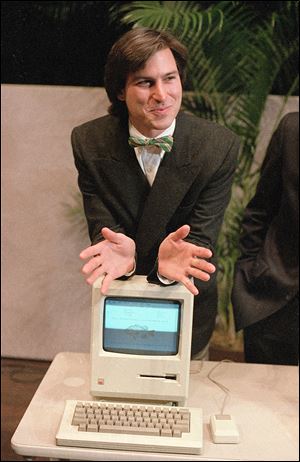
Apple’s Mac marks 30th year
Computer’s simplified icons, printing options changed industry
1/24/2014
On Jan. 24, 1984, Steve Jobs, chairman of the board of Apple Computer, leans on the new ‘Macintosh’ in Cupertino, Calif. Early Macs showed a happy face when they started up.
ASSOCIATED PRESS

On Jan. 24, 1984, Steve Jobs, chairman of the board of Apple Computer, leans on the new ‘Macintosh’ in Cupertino, Calif. Early Macs showed a happy face when they started up.
NEW YORK — Look around. Many of the gadgets you see drew inspiration from the original Mac computer.
Computers at the time typically required people to type in commands. Once the Mac came out 30 years ago today, people could use a graphical user interface. Available options were organized into menus. People clicked icons to run programs and dragged and dropped files to move them.
The Mac introduced real-world metaphors such as using a trash can to delete files. It brought us fonts and other tools once limited to professional printers. Most importantly, it made computing and publishing easy enough for the average person to learn and use.
Apple sparked a revolution in computing with the Mac. In turn, that sparked a revolution in publishing.
These concepts once existed only in research labs — primarily Xerox Corp.’s Palo Alto Research Center. Apple co-founder Steve Jobs and his team got much of its inspiration from PARC, which they visited while designing the Mac.
The Mac has had “incredible influence on pretty much everybody’s lives all over the world since computers are now so ubiquitous,” said Brad Myers, a professor at Carnegie Mellon University’s Human-Computer Interaction Institute. “Pretty much all consumer electronics are adopting all of the same kinds of interactions.”
Apple didn’t invent these tools, nor was the Mac the first to use them. Xerox sold its own mouse-based Star computer, and Apple’s Lisa beat the Mac by months. But Lisa cost $10,000.
Xerox used a three-button mouse in its prototype computer. Apple settled on one, allowing people to keep their eyes on the screen without worrying about which button to press.
Apple insisted on uniformity, so copying and pasting text and deleting files would work the same way from one application to another. That reduced the time it would take to learn a new program.
And Apple put a premium on design. Early Macs showed a happy face when they started up. Icons and windows had rounded corners. Such details made computers appear friendlier and easier to use to the user, Mr. Myers says.
For years, though, it was mostly a niche product for publishers, educators, and graphics artists. Corporate users stuck with IBM Corp. and its clones, especially as Microsoft’s Windows operating system grew to look like Mac’s software.
The Mac was $2,495 when it came out on Jan. 24, 1984.
Now the world’s most valuable company, Apple Inc. nearly died in the 1990s as its market share dwindled. After a 12-year exile, Mr. Jobs returned in 1997 to head the company. A year later, he introduced the iMac, a desktop computer with shapes and colors that departed from beige Windows boxes at the time.
Then came the iPod music player in 2001, the iPhone in 2007, and the iPad tablet in 2010.
In recent years, PCs have declined as consumers turn to mobile devices. Apple sold 16 million Macs in the fiscal year ending Sept. 28, down 10 percent from a year earlier. By contrast, iPhones sales grew 20 percent to 150 million and iPads by 22 percent to 71 million.